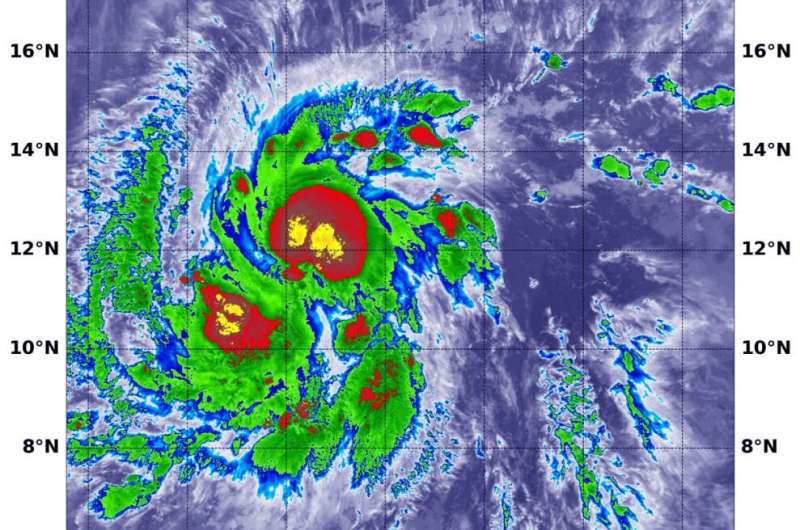NASA tropical storm Erick strengthening

Infrared imagery from NASA's Aqua satellite revealed a stronger Tropical Storm Erick in the Eastern Pacific Ocean. Satellite imagery revealed two areas of very cold cloud tops indicating powerful thunderstorms as the storm is on the cusp of hurricane status.
Erick developed as Tropical Depression Six-E on Saturday, July 27, 2019. It formed about 1,215 miles (1,955 km) southwest of the southern tip of Baja California. Mexico. At 5:15 p.m. EDT that day, it strengthened into a tropical storm and was re-named Erick.
NASA's Aqua satellite used infrared light to analyze the strength of storms and found the bulk of them in the southern quadrant. Infrared data provides temperature information, and the strongest thunderstorms that reach high into the atmosphere have the coldest cloud top temperatures.
On July 29 at 6:35 a.m. EDT (1035 UTC),the Moderate Imaging Spectroradiometer or MODIS instrument that flies aboard NASA's Aqua satellite gathered infrared data on Tropical Storm Erick were around the center and in a band of thunderstorms southwest of the center where cloud top temperatures were as cold as minus 70 degrees Fahrenheit (minus 56.6 Celsius).
Cloud top temperatures that cold indicate strong storms with the potential to generate heavy rainfall. Those strongest storms were south and southeast of the center of the elongated circulation. Recent microwave data reveal the development of an eye.
The National Hurricane Center or NHC said, "At 5 a.m. HST (Hawaii local time) (1500 UTC) on July 29, 2019, the center of Tropical Storm Erick was located near latitude 12.3 degrees north and longitude 136.9 degrees west. That's about 1,310 miles (2,110 km) east-southeast of Hilo, Hawaii.
Erick is moving toward the west near 17 mph (28 kph). A turn to the west-northwest and a slower forward speed is expected to start on Tuesday and continue through Wednesday. The estimated minimum central pressure is 991 millibars. Maximum sustained winds are near 70 mph (110 kph) with higher gusts. NHC said that the environment is currently favorable for intensification, and Erick is expected to become a hurricane at any time.
Erick can potentially become a major hurricane on Tuesday, July 30, and weakening trend is forecast to begin by later in the week.
Provided by NASA's Goddard Space Flight Center




















